Samsung Galaxy Note evolution: Here's how it has changed over the years
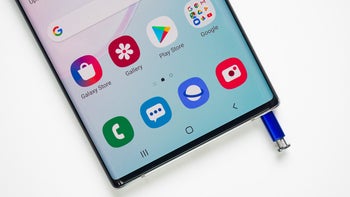
The device that most certainly singlehandedly kickstarted the large-screen trend and became widely-accepted as the first commercially-successful phablet was 2011's Samsung Galaxy Note. What's more, the "phablet" portmanteau term (a word concoction between "phone" and "tablet") essentially made its debut alongside the first Note. It was obnoxiously large for its time, overspec'd, and was going to be a disastrous flop because nobody wants to carry a monstrous 5.3" device around. Or so they said.
The first Galaxy Note did not tank. Actually, it pioneered what is now one of the most popular and successful smartphone lineups to date.
With time, devices grew in size, and Samsung Notes are no longer the largest devices on the block, but they still have an undeniable charisma. Though it could be speculated that they are not as popular as the regular Galaxy lineup, each and every Galaxy Note has been generally accepted as the yardstick for big phone - they are usually the most power-laden and feature-packed Samsung devices.
With time, devices grew in size, and Samsung Notes are no longer the largest devices on the block, but they still have an undeniable charisma. Though it could be speculated that they are not as popular as the regular Galaxy lineup, each and every Galaxy Note has been generally accepted as the yardstick for big phone - they are usually the most power-laden and feature-packed Samsung devices.
Samsung Galaxy Note series evolution:
- 2011: original Galaxy Note
- 2012: Galaxy Note II
- 2013: Note 3, Note 3 Neo
- 2014: Note 4
- 2015: Note 5
- 2016: Note 7 (recalled)
- 2017: Note 8
- 2018: Note 9
- 2019: Note 10 & Note 10+
Samsung Galaxy Note
The Godfather of the Galaxy Note series
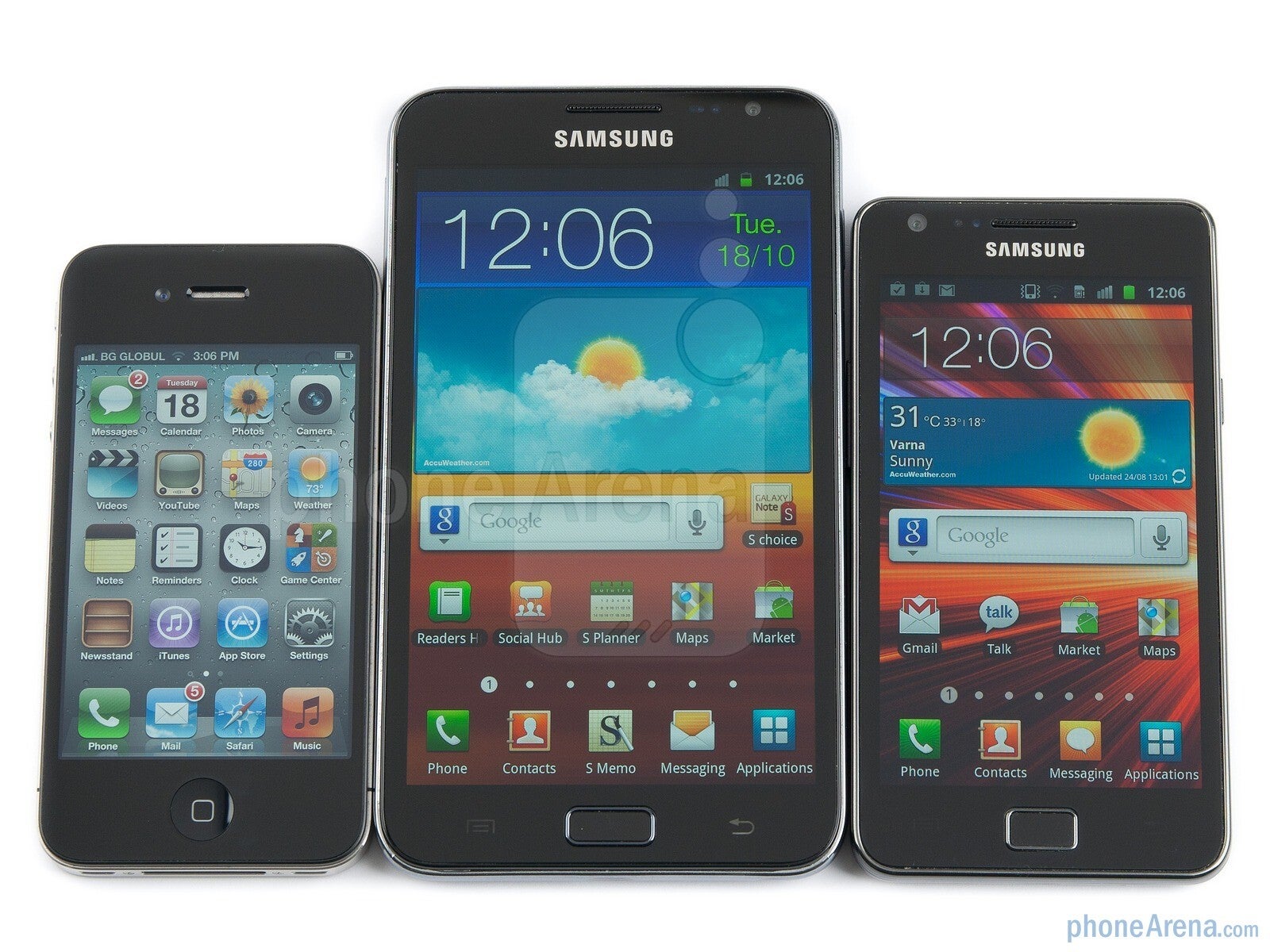
The original Note (in the middle) was a much larger phone than all others on the market
- 5.3" Super AMOLED display
- Snapdragon S3/Exynos 4 chipset
- 1GB RAM
- 2,500mAh battery
Back in September 2011, the category-defining "phablet" (a phone big enough to be considered a mixture of a phone and tablet, hence phablet) was the first top-end Android device to sport a retractable stylus; the first with such a large and pixel-dense display - a gigantic (at the time) 5.3" Super AMOLED one with a resolution of 800 x 1280 pixels, a pentile matrix, and a pixel density of 285ppi, which was pretty impressive for a device with such a large display back in 2011.
The niche device was by no means flawless, mind you. It failed to deliver in both the call quality and camera departments. Still, let's not forget that Samsung only decided to test the waters with the original Galaxy Note and we have to give credit to the company for amping its game with the subsequent iterations of its phablet line.
Although the Samsung Galaxy Note was initially criticized for the large display and overall size, both considered to be an overkill back in 2011, the first phablet from South Korea quickly dissipated the pessimism that arose and became a hit on the market - Samsung had sold roughly 10 million units for less than a year. Undoubtedly, the wild success of the first Galaxy Note device cemented the lineup's spot in Samsung's portfolio.
Check out our review of the Galaxy Note here
Samsung Galaxy Note II
Never change a winning team
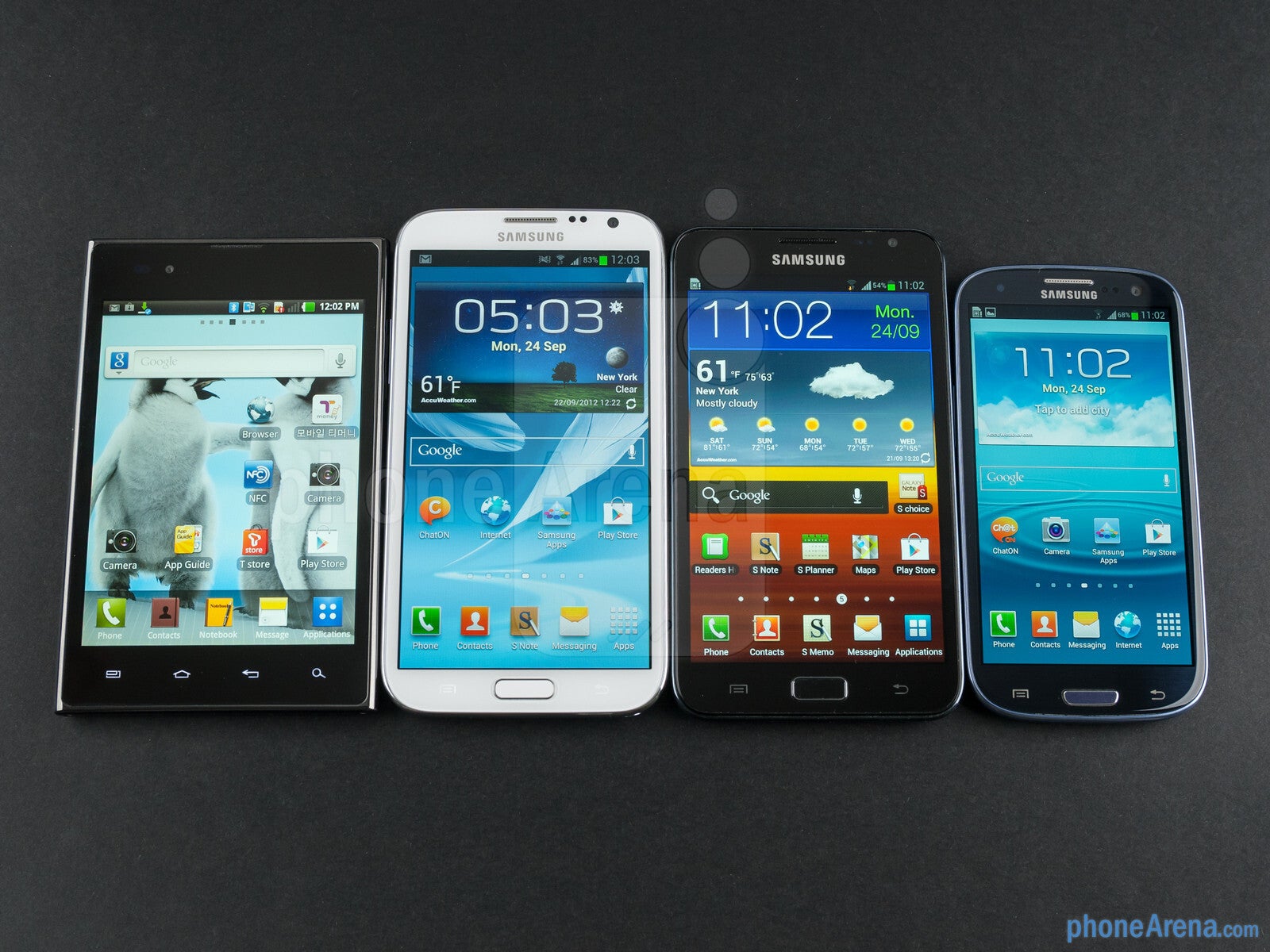
The Note II (second, left to right) was an even bigger phone and more powerful
- 5.5" Super AMOLED display
- Snapdragon 600/Exynos 4412
- 2GB RAM
- 3,100mAh battery
After the success of the original Galaxy Note, Samsung simply had to release a refined successor. The Samsung Galaxy Note II had grown in almost each and every aspect. Starting with the design, which was directly inspired from Samsung's 2012 flagship, the Galaxy S III, and moving on to the specs sheet, which was quite impressive on its own.
The device sported a 5.5-inch Super AMOLED display with a resolution of 720 x 1280 pixels, which worked out a pixel density of 265ppi. The chipset of choice was a quad-core Samsung Exynos 4412, clocked at 1.6GHz, and the respectable at the time 2GB of RAM, which ensured that the Galaxy Note II is a multitasking beast. A 3,100mAh battery also kept the lights on and made sure that the Samsung Galaxy Note II had a mesmerizing battery life.
Samsung had kept an ear close to the ground and had perfected the areas in which the first Galaxy Note was underperforming. The S Pen in the Galaxy Note II was further improved, the camera produced outstanding images, and the call quality was commendable. All in all, what the Galaxy Note started, the Galaxy Note II pushed to great extents.
The device sported a 5.5-inch Super AMOLED display with a resolution of 720 x 1280 pixels, which worked out a pixel density of 265ppi. The chipset of choice was a quad-core Samsung Exynos 4412, clocked at 1.6GHz, and the respectable at the time 2GB of RAM, which ensured that the Galaxy Note II is a multitasking beast. A 3,100mAh battery also kept the lights on and made sure that the Samsung Galaxy Note II had a mesmerizing battery life.
Samsung had kept an ear close to the ground and had perfected the areas in which the first Galaxy Note was underperforming. The S Pen in the Galaxy Note II was further improved, the camera produced outstanding images, and the call quality was commendable. All in all, what the Galaxy Note started, the Galaxy Note II pushed to great extents.
Check out our review of the Galaxy Note II here
Samsung Galaxy Note 3
Faux leather, raw power
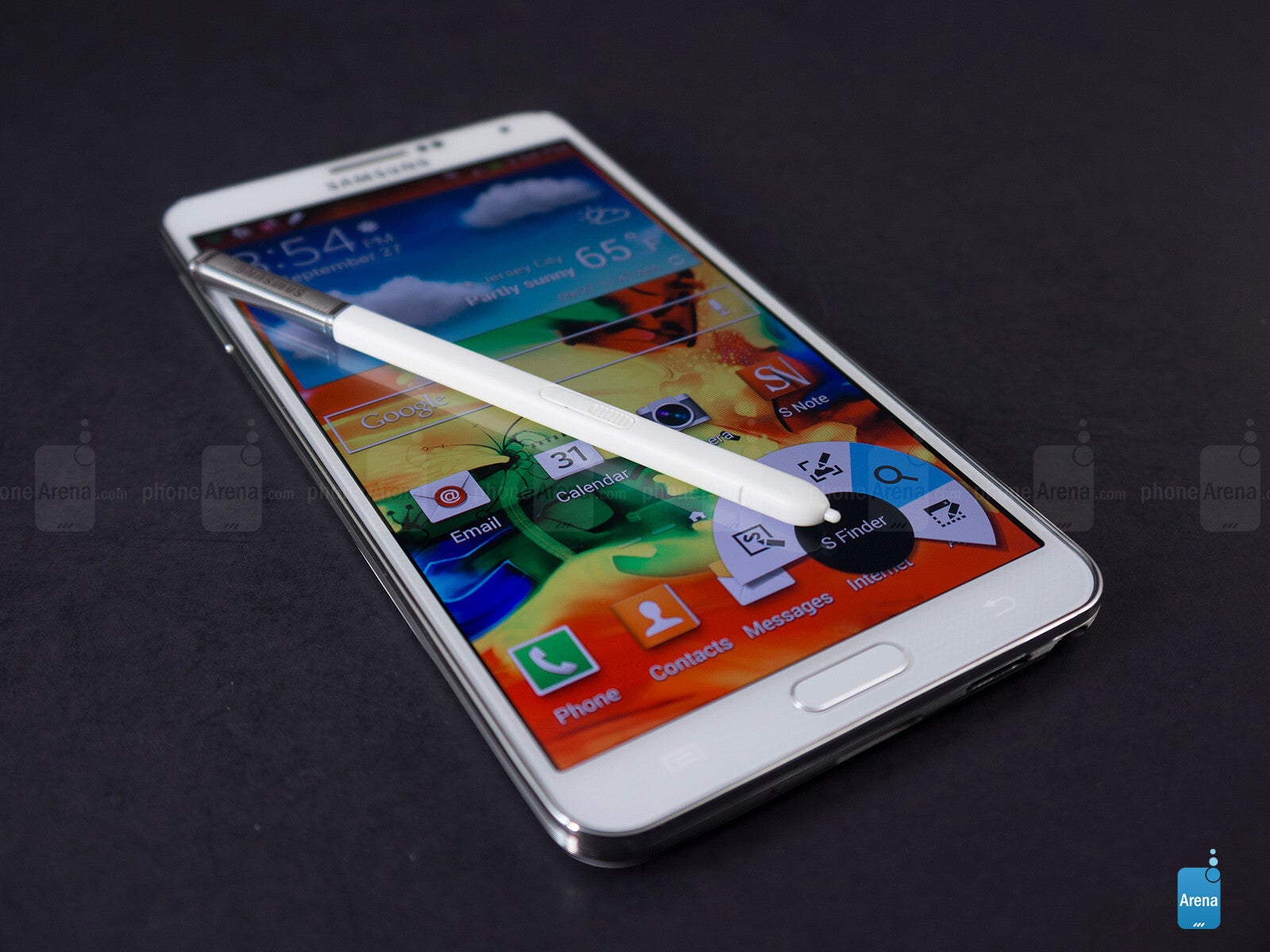
A new style of a Note with a beautiful faux-leather finish
- 5.7" Super AMOLED display
- Snapdragon 800/Exynos 5 Octa
- 3GB RAM
- 3,200mAh battery
The "phablet" showcased the manufacturer's newest design language at the time, with the faux leather stitching of the rear cover imitating the real deal with the hope of an additional 'premiumness'. Many firsts are associated with this phablet, too. Similar to the original Galaxy Note, it came in two variations - the LTE-enabled one made use of a quad-core, 2.3GHz Snapdragon 800 SoC, whereas the 3G-only version was powered by a octa-core Samsung Exynos 5 Octa, humming at 1.9GHz.
Once again, the flagship phablet had grown up in size, as it featured a 5.7-inch Super AMOLED display with a resolution of 1080 x 1920 pixels (another first for the Galaxy Note series), ensuring a high pixel density of 386ppi. The 13MP camera at the rear could shoot 4K video, another first for Samsung. The 3,200mAh beneath the removable back cover, however, failed to put the Galaxy Note 3 near the top of our battery life chart.
Another key feature was the amount of RAM - the 3GB of operational memory on board further-improved the multitasking capabilities of the device and ensured that it sat among the most power-laden representatives of its category. Samsung had also perfected its TouchWiz interface and implemented a slew of improvements to the S Pen stylus, the signature feature of the family. In fact, Samsung had thrown everything but the kitchen sink inside the Galaxy Note 3 feature-wise and hardly anything was missing.
Once again, the flagship phablet had grown up in size, as it featured a 5.7-inch Super AMOLED display with a resolution of 1080 x 1920 pixels (another first for the Galaxy Note series), ensuring a high pixel density of 386ppi. The 13MP camera at the rear could shoot 4K video, another first for Samsung. The 3,200mAh beneath the removable back cover, however, failed to put the Galaxy Note 3 near the top of our battery life chart.
Another key feature was the amount of RAM - the 3GB of operational memory on board further-improved the multitasking capabilities of the device and ensured that it sat among the most power-laden representatives of its category. Samsung had also perfected its TouchWiz interface and implemented a slew of improvements to the S Pen stylus, the signature feature of the family. In fact, Samsung had thrown everything but the kitchen sink inside the Galaxy Note 3 feature-wise and hardly anything was missing.
Check out our review of the Galaxy Note 3 here
Samsung Galaxy Note 3 Neo
The Galaxy Note experience for the masses
- 5.5" Super AMOLED display
- Snapdragon 400/800/Exynos 5 Hexa
- 2GB RAM
- 3,100mAh battery
Announced in the beginning of 2014, the Galaxy Note 3 Neo was, by all means, a toned-down version of the Galaxy Note 3 and discerned from the latter in several key areas. First of all, the featured Super AMOLED display had shrunk to 5.5 inches and the resolution was now 720 x 1280 pixels, meaning that the Note 3 Neo's display had a not-so-high pixel density of 267ppi.
A hexa-core Samsung Exynos 5 Hexa SoC that hummed at 1.7GHz kept the whole shebang running. The amount of on-board RAM was also less than the Note 3 - 2GB of RAM, while the rear camera was a more modest 8MP one. The battery compartment also received a jab under the belt - the juicer's capacity got downsized to 3,100mAh, but that was actually a winning move, as the Galaxy Note 3 Neo ran circles around the Note 3 in terms of battery endurance.
Hardware-wise, the Note 3 Neo was somewhat closer to the Galaxy Note II, but the remainder of the toned-down phablet remained generally the same. It also employed the faux leather design language, though slightly altered at the rear. Although it was marketed as being an affordable version of the Note 3, the Note 3 Neo was still priced a little bit higher.
A hexa-core Samsung Exynos 5 Hexa SoC that hummed at 1.7GHz kept the whole shebang running. The amount of on-board RAM was also less than the Note 3 - 2GB of RAM, while the rear camera was a more modest 8MP one. The battery compartment also received a jab under the belt - the juicer's capacity got downsized to 3,100mAh, but that was actually a winning move, as the Galaxy Note 3 Neo ran circles around the Note 3 in terms of battery endurance.
Hardware-wise, the Note 3 Neo was somewhat closer to the Galaxy Note II, but the remainder of the toned-down phablet remained generally the same. It also employed the faux leather design language, though slightly altered at the rear. Although it was marketed as being an affordable version of the Note 3, the Note 3 Neo was still priced a little bit higher.
The new phablet cornerstone

- 5.7" Super AMOLED display
- Snapdragon 805/Exynos 5 Octa
- 3GB RAM
- 3,220mAh battery
Samsung's Note 4 was the first globally-available Samsung device to arrive with a Quad HD Super AMOLED display as well as a metal frame.
The Note 4 got it right in the hardware department, though - it is destined to be the first globally available handset with a power-laden Snapdragon 805 SoC inside (in certain versions, that is).
Running at 2.7GHz, this quad-core SoC ensures for a hassle-free user experience through almost any task you might through at the Note 4. The other variations of the device are powered by a 1.9GHz octa-core Exynos 5433 chipset.
Similar to the Galaxy Note 3, the Galaxy Note 4 comes with 3GB of RAM, which means that its multi-tasking abilities are top notch once again. All in all, the Galaxy Note 4 once again set new standards in the phablet category, similar to its predecessors over the years. The phablet already proved that it is a pretty capable cameraphone, too, winning camera comparisons at the time.
The Note 4 got it right in the hardware department, though - it is destined to be the first globally available handset with a power-laden Snapdragon 805 SoC inside (in certain versions, that is).
Running at 2.7GHz, this quad-core SoC ensures for a hassle-free user experience through almost any task you might through at the Note 4. The other variations of the device are powered by a 1.9GHz octa-core Exynos 5433 chipset.
Similar to the Galaxy Note 3, the Galaxy Note 4 comes with 3GB of RAM, which means that its multi-tasking abilities are top notch once again. All in all, the Galaxy Note 4 once again set new standards in the phablet category, similar to its predecessors over the years. The phablet already proved that it is a pretty capable cameraphone, too, winning camera comparisons at the time.
Samsung Galaxy Note Edge
The bleeding edge technology
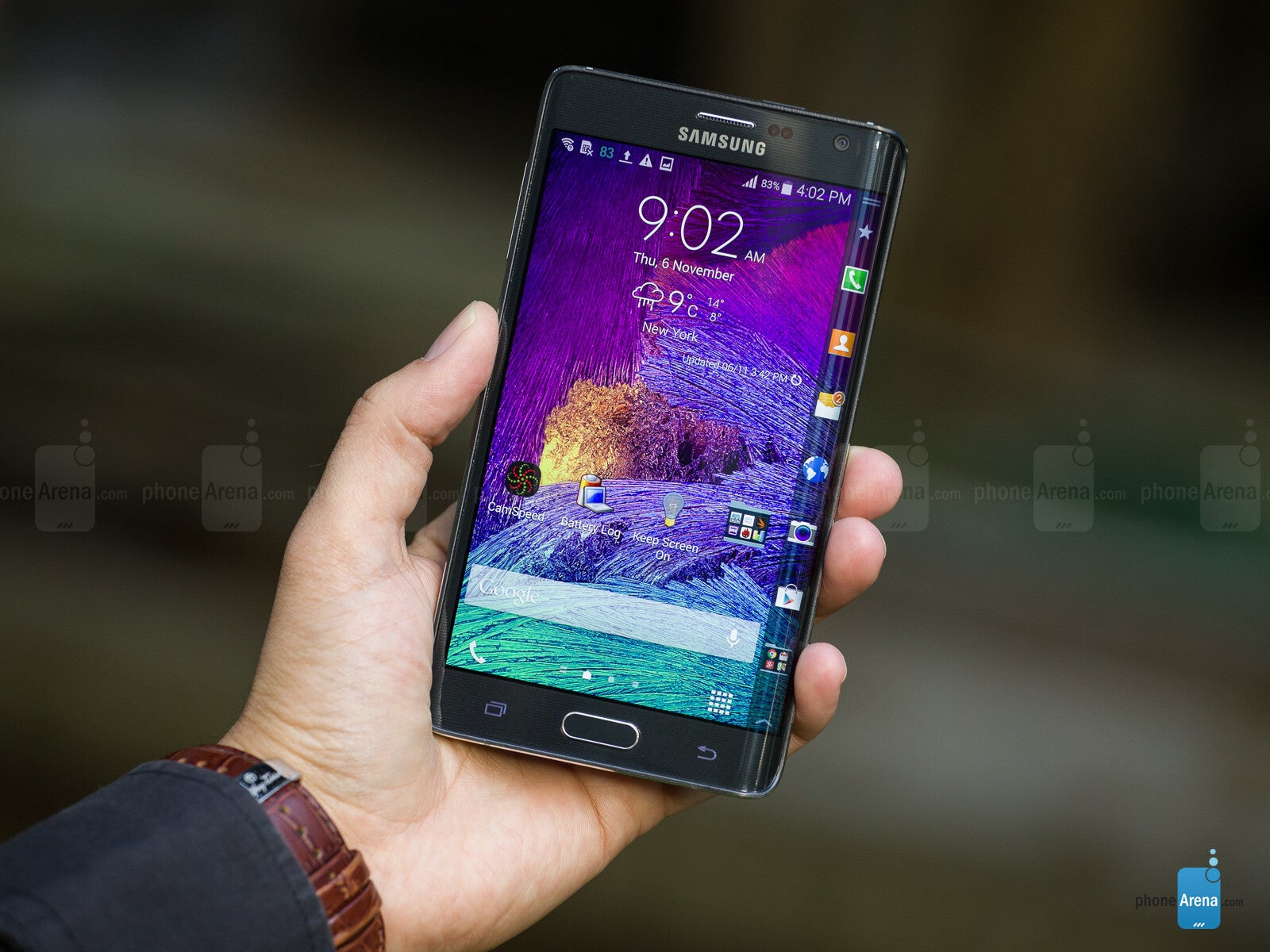
- 5.6" Super AMOLED display
- Snapdragon 805/Exynos 5 Octa
- 3GB RAM
- 3,000mAh battery
The compelling Galaxy Note Edge and its curious stretching-to-the-side screen came out of the blue, as hardly anyone expected Samsung to unveil device with such an intricate form factor. Apart from the noticeable differences in the display (which has been also downsized to 5.6 inches), the Galaxy Note Edge is similar to the Galaxy Note 4 hardware- and design-wise.
Although the Note Edge is a niche puppy from the Galaxy Note litter, it is yet another water-testing device that reveals what's Samsung's roadmap for its successful phablet family. The overlapping display of the Note Edge was interesting and head-turning, and would set the stage for future Samsung launches.
Samsung Galaxy Note 5
Made of European tears
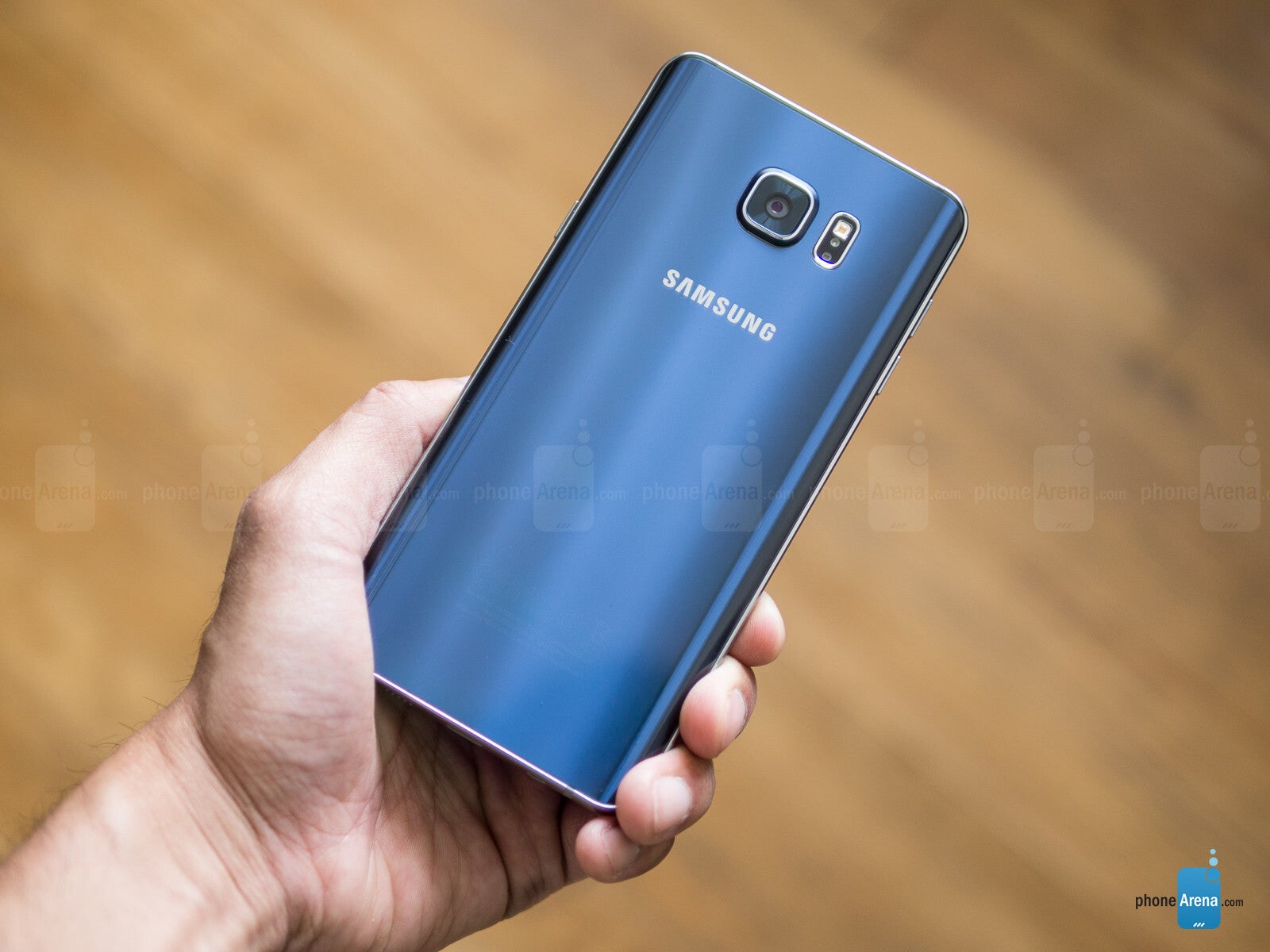
- 5.7" Super AMOLED
- Exynos 7 Octa
- 4GB RAM
- 3,000mAh
Lots of ink was spilled on Samsung's Galaxy Note 5, which definitely split the fanbase. True, it inherited the mesmerizing glass-metal design of the Galaxy S6, but also lost its microSD card slot and the removable battery, which was regarded as pure sacrilege by many. No IR blaster on that one, too. Also, Samsung's weird decision to not sell the Note 5 in Europe certainly hurt the overall sales of the handset and made lot of people unhappy.
But seen in a vacuum, the Note 5 was and actually still is an awesome phone that ticked many of the boxes users had been lusting for a long time. Apart from the appealing design and rather good screen-to-body size ratio, the Note 5 also boasted the excellent Exynos 7420 chipset which was one of the top-performers of 2015. Paired with 4 gigs of RAM for a worthy multi-tasking experience.
The S Pen, the main selling point of every Note so far, also scored a pretty sweet update - now with 2048 levels of pressure sensitivity, the stylus allowed for much finer penmanship. On the software side, the Note 5 introduced a couple of features, most importantly screen-off write which essentially allowed you to flick out the stylus and jot down a note without even powering up the Note 5. Oh, and it was the first S Pen to feature a clickable auto-eject mechanism.
Check out our Galaxy Note 5 review here
Samsung Galaxy Note 7
Explosive
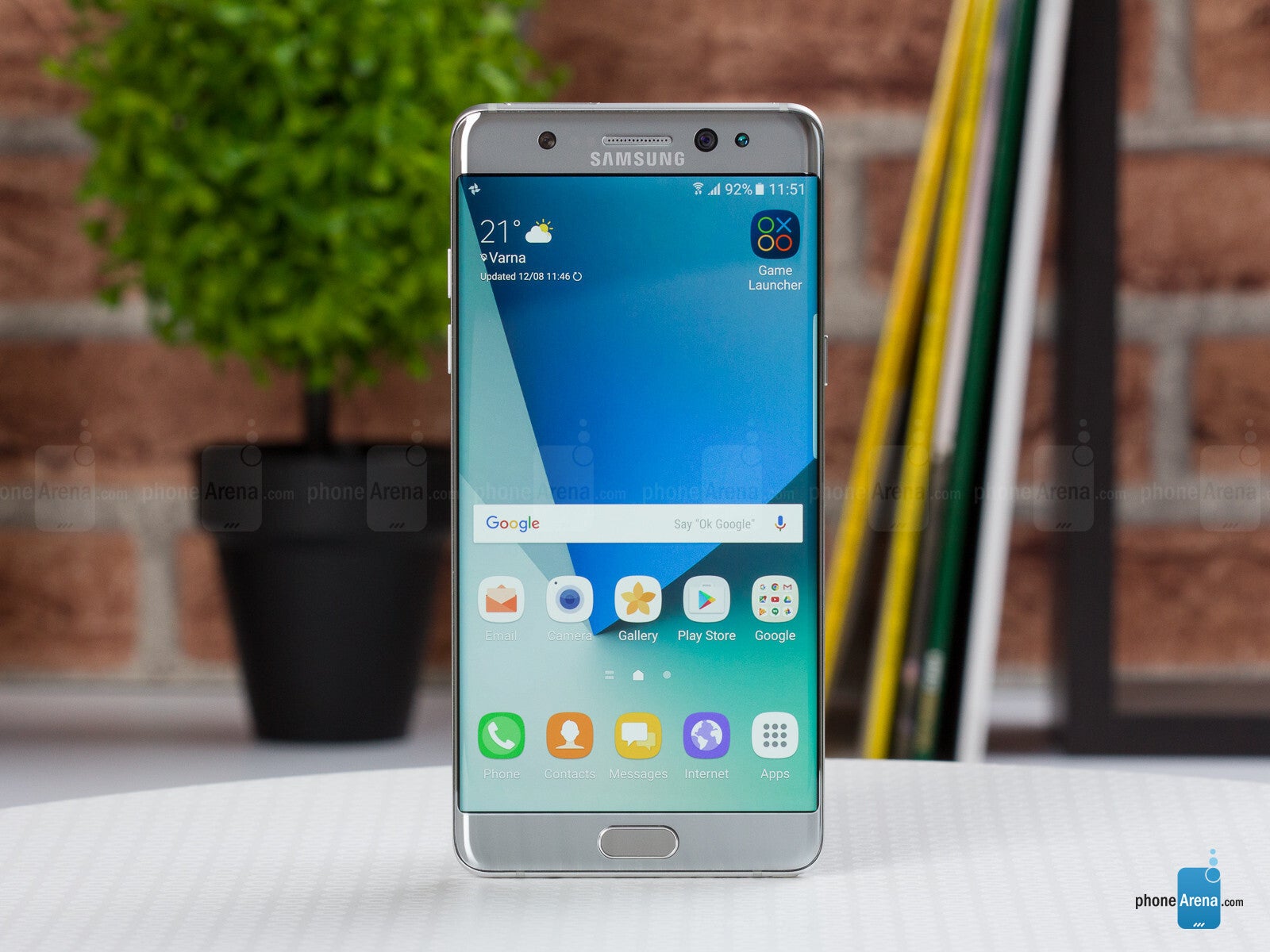
- 5.7" Super AMOLED
- Snapdragon 820/Exynos 8890
- 4GB RAM
- 3,500mAh
The Galaxy Note 7 is the phone that Samsung probably wants to forget and erase from history: the good looking device was equipped with faulty batteries that would spontaneously combust. The issue was first noticed by a few users and Samsung was quick to react by pulling the phone off the market.
And yes, there was no Galaxy Note 6 at all: the number was skipped because the Note series were one number behind the S series and Samsung did not want to have customers wondering if the lower number was associated with lesser features.
Check out our Galaxy Note 7 review here
Samsung Galaxy Note 8
A brave restart
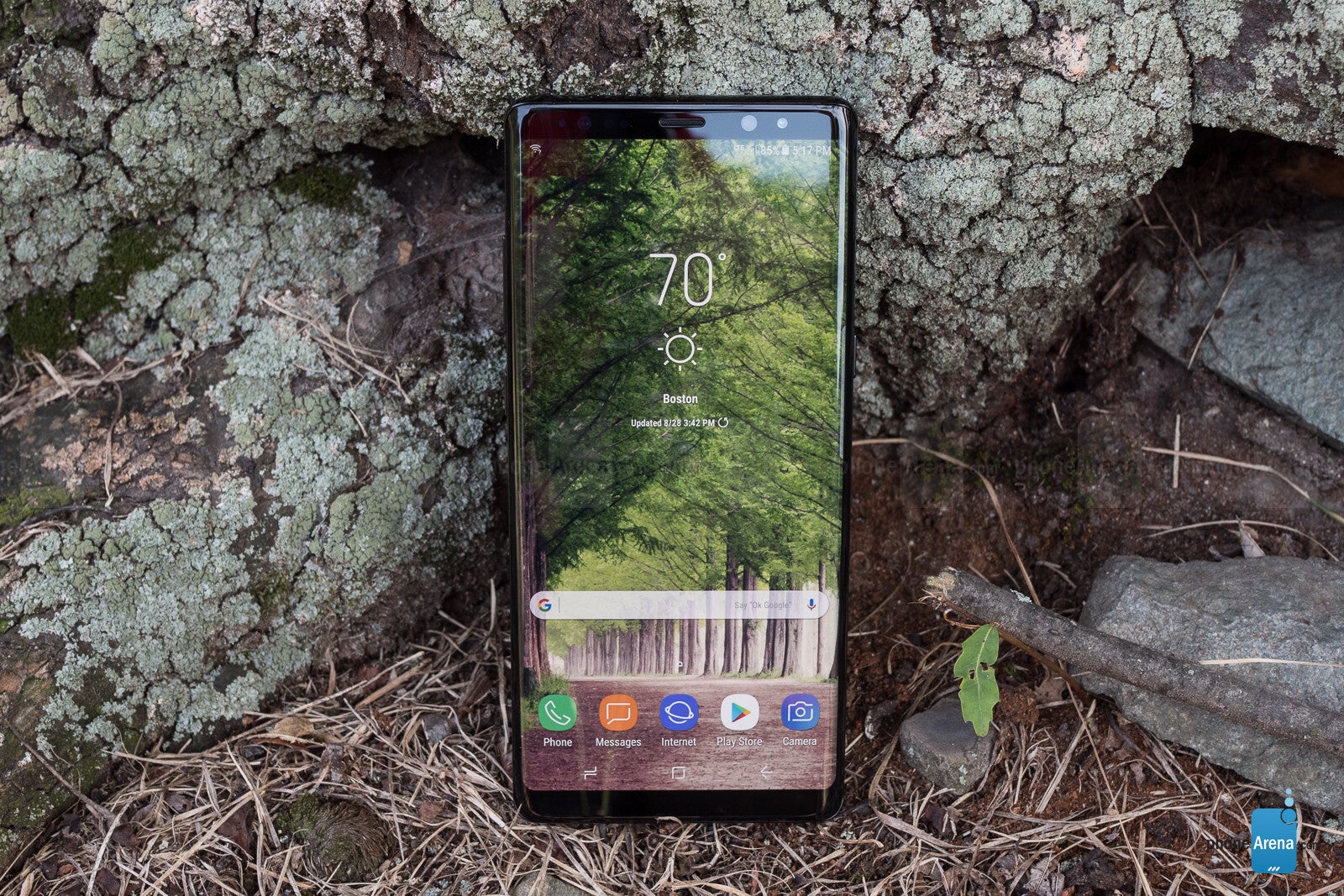
- 6.3" Super AMOLED
- Snapdragon 835/Exynos 8895
- 6GB RAM
- 3,300mAh
An important milestone in the Note series, the Note 8 was a brave step for Samsung: despite the fiasco that was the exploding Note 7, the company insisted on resurrecting one of its most loved and most profitable brands. The Note 8 has undergone various battery security checks and it features a sleek glass and metal design.
Innovations here include a larger screen, additional memory, and a telephoto camera that for the first time allows users to shoot Portrait images with the Live Focus mode that blurs the background and gives images a more professional look.
Check out our Galaxy Note 8 review here
Samsung Galaxy Note 9
Finally, a bigger battery
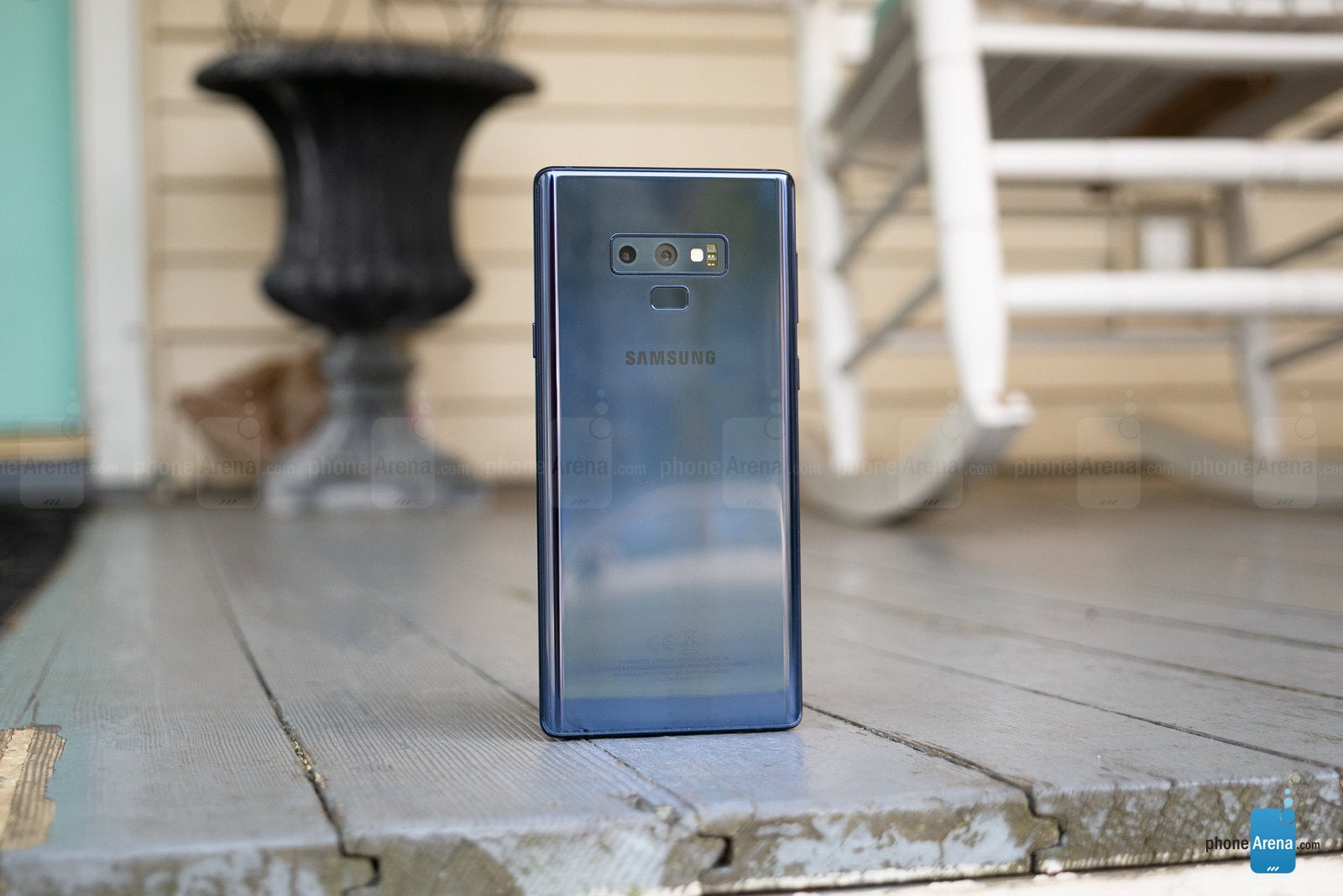
- 6.4" Super AMOLED
- Snapdragon 845/Exynos 9810
- 6/8GB RAM
- 4,000mAh battery
The Galaxy Note 9 improves upon one of the most overlooked aspects of the Note experience: battery life. With a 4,000mAh battery on board it is able to elevate the Note series to a true full-day battery life status.
Samsung also changes the camera layout with a quirky arrangement that looks a bit strange, but also different. Under the hood, the phone is powered by the Snapdragon 845 chip (international versions get the Exynos 9810 processor) and has 6GB of RAM. It also doubles the on-board storage with 128GB of internal storage, an important upgrade over the 64 gig Note 8.
The S Pen for the first time in the Note series features Bluetooth LE support, so you can use it as a wireless controller for the Note. You can remotely snap photos with a click of the S Pen button, navigate through a slideshow presentation, and control media playback.
Check out our Galaxy Note 9 review here
Samsung Galaxy Note 10 & Note 10+
Two Note phones, a big and a smaller one
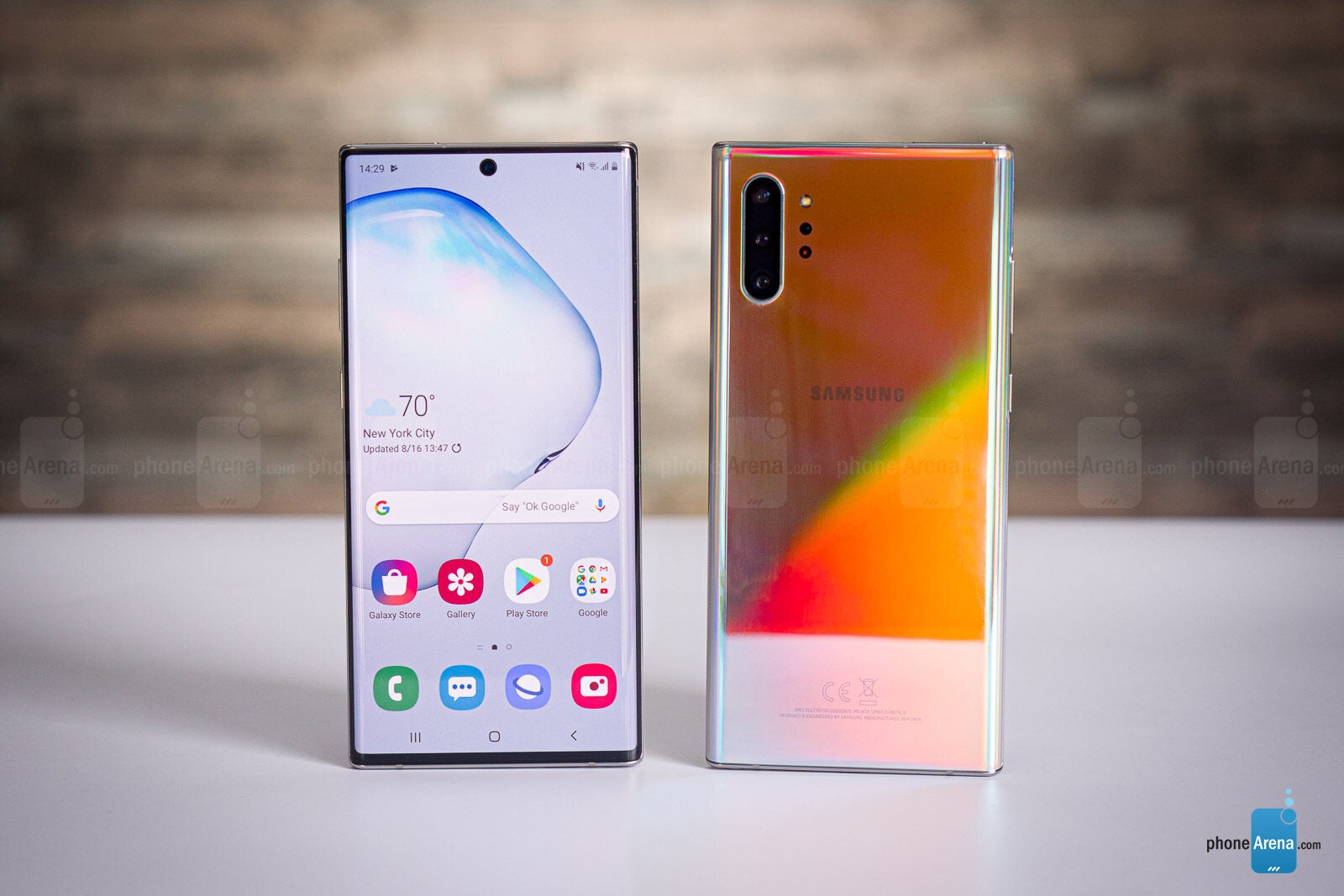
- 6.8" Optic AMOLED display
- Snapdragon 855/Exynos 9825
- 12GB RAM
- 4,300mAh
For the first time in 2019, the Note series comes in two different flavors: a Note 10+ with a giant screen, large battery and the most options for the loyalists, as well as a more compact Note 10 with a smaller display for those who want the S Pen experience in a smaller form factor (and a slightly lower price).
The Note 10 series deliver a big improvement in design and styling: the display stretches all the way to the edge with only a delicate punch hole at the top interrupting the all-screen experience. Bezels are almost non-existant, and the phone is now considerably thinner and more ergonomic than the Note 9. The new Aura Glow finish is also a looker as it changes color depending on the light it reflects and it looks stunning.
Under the hood, the Note 10 series are pretty much identical to the S10 series released earlier in 2019 with a Snapdragon 855 chip (international models get an Exynos 9825 processor), as well as a nearly identical array of cameras. The S Pen in 2019 undergoes a redesign too as it is now much more solidly build, featuring a unibody design and a vast array of features including the capability to control the camera.












Things that are NOT allowed: